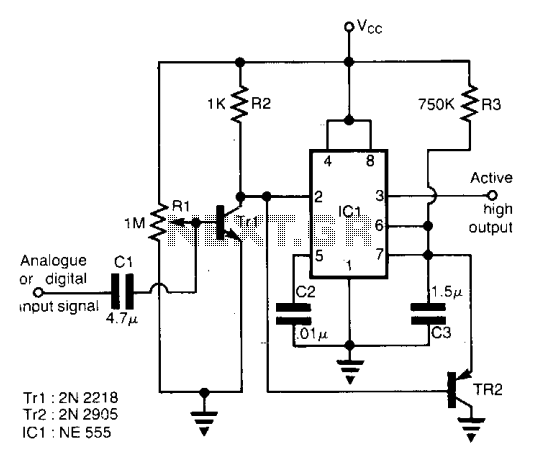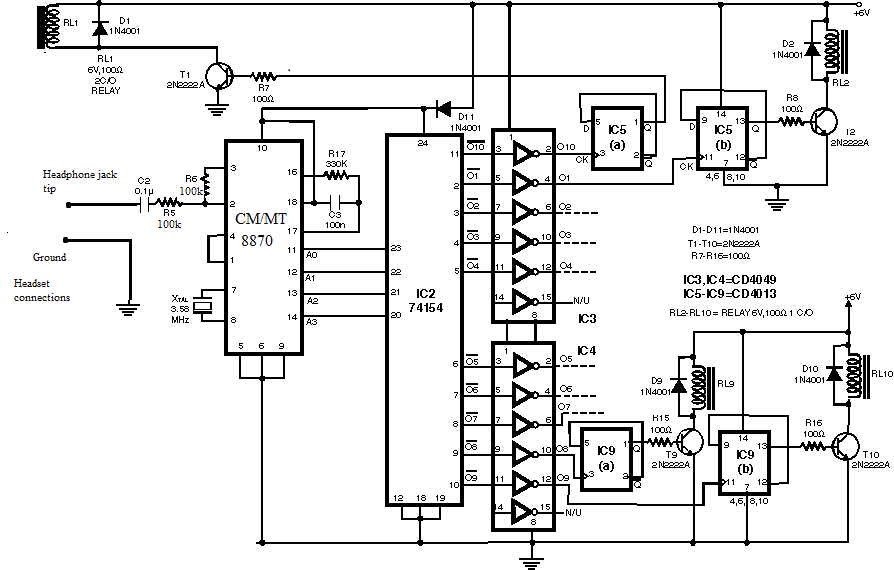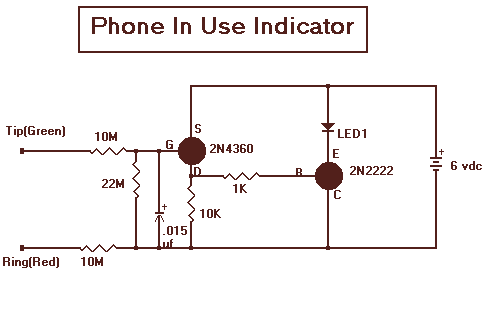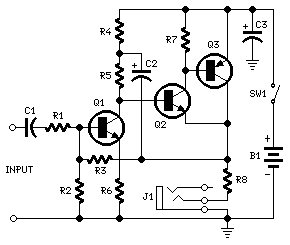
phone
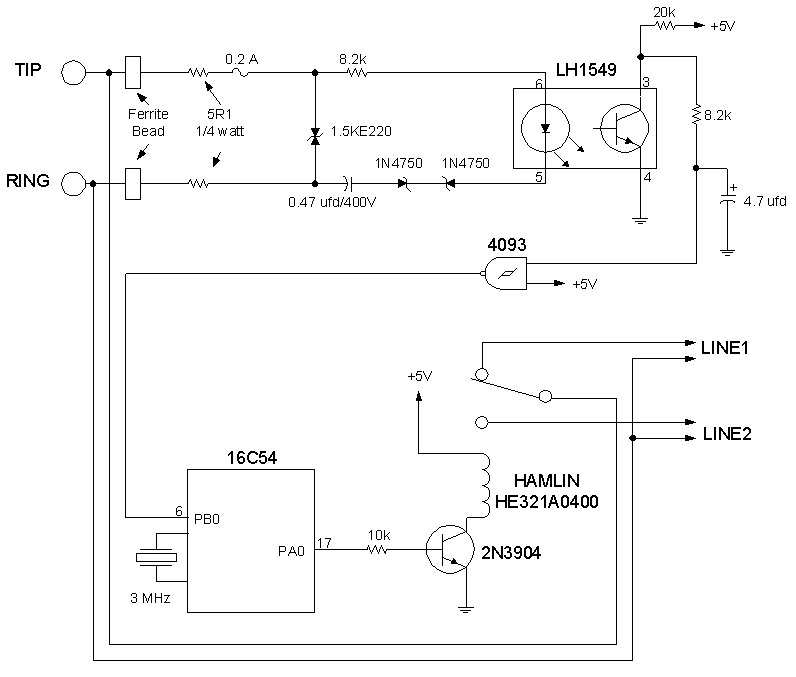
Distinctive ringing allows phone service customers to have two phone numbers using a single twisted-pair line. The standard ring cadence indicates that someone is calling on number X, while the distinctive ring cadence signifies that someone is calling on number Y. This differentiation enables users to identify which number is being called. However, devices such as answering machines cannot distinguish between the two. The following is a complete design of a smart switch based on a PIC microcontroller from Microchip Technology, Inc. This switch detects the ringing pattern and routes the call accordingly. The schematic is illustrated in Figure 1. The accompanying assembly code is available upon request. The Data Access Arrangement is designed for registration in the United States and Canada. A normal ring consists of 2 seconds ON followed by 4 seconds OFF, while distinctive ringing has a pattern of 1 second ON, 0.75 second OFF, 1 second ON, and 4 seconds OFF. Consequently, if a ring lasts more than 1 second, it is classified as normal. The switch operates by measuring time intervals and ignores the first ring, commencing measurements on the second ring. The incoming line is connected to one of the two output lines. Once a decision is made, the relay remains in that state until the next ring cadence. Upon power-up, the relay is open. Since the switch requires two rings before making a decision, connected devices like answering machines should be programmed to respond to 4 rings. The ring detector features one phone line input and two outputs, switching the input to one of the two outputs based on the type of ringing detected. When ringing ceases, the relay maintains its last position. The algorithm for operation is as follows: start, wait for ring, check if valid; if not, return to start; wait for the end of the ring, measure the next ring; if longer than 1.5 seconds, go to line 1; otherwise, go to line 2. Line 1 switches the relay to line 1 (normal ring) and returns to start. Line 2 switches the relay to line 2 (distinctive ring), waits for the ringing to stop, and returns to start. The option register values are defined as follows: rts equ 0x20 (set for external clock), rte equ 0 (increment on low-to-high), psa equ 0 (prescale rtcc), ps2 equ 0 (prescale value = 16), ps1 equ 2 (clock period of 21.8 msec to rtcc), and ps0 equ 1. The output port is initialized by clearing the output start and configuring the relay. The time_check subroutine verifies whether rtcc is zero, using the zero flag for validation.
The smart switch design leverages a PIC microcontroller, which is programmed to differentiate between standard and distinctive ringing patterns. This is crucial for users who manage multiple lines through a single telephone connection. The microcontroller continuously monitors the incoming line for ring signals, analyzing the timing of these signals to determine the appropriate response.
The detection mechanism is based on a time measurement algorithm that effectively distinguishes between the two ringing cadences. The normal ring pattern, with longer durations, is easily identifiable, while the distinctive ring requires precise timing to ensure correct routing. The decision-making process begins after the first ring is ignored, ensuring that transient noise or false signals do not trigger an erroneous relay action.
The system's reliability is enhanced by the requirement for two rings before a decision is made. This feature is particularly beneficial for users with answering machines, allowing them to set their devices to respond only after a specific number of rings, thus preventing premature activation.
The relay's operation is straightforward: upon identifying the type of ring, the microcontroller commands the relay to switch to the appropriate output line. This allows the call to be routed to the correct device, whether it is a phone or an answering machine. The relay maintains its state until the next ringing event, ensuring minimal disruption to ongoing calls.
The assembly code provided with the design outlines the initialization and operational logic of the microcontroller. It includes provisions for setting up the clock source and configuring the input and output ports. The time_check subroutine plays a critical role in ensuring that the timing measurements are accurate, which is essential for the reliable operation of the switch.
In summary, this smart switch design provides a robust solution for managing multiple phone numbers over a single line, utilizing a microcontroller to intelligently route calls based on distinctive ringing patterns. The combination of time measurement, relay control, and programmable logic results in a versatile and effective telephone management system.Distinctive ringing lets phone service customers have two phone numbers with only one twisted-pair line. The standard ring cadence tells the customer that someone is calling on number X, while the distinctive ring cadence tells him (her) that someone is calling on number Y.
People can easily tell which ring is which. But equipment like answering m achines can`t. Here is the complete design of a smart switch, based on a PIC (Microchip Technology, Inc. , 2355 West Chandler Blvd. , Chandler, AZ) microcontroller, that will detect the ring and route the call appropriately. The schematic is shown in figure 1. The assembly code (contact us if you would like a text file of the code) follows the figure. The Data Access Arrangement shown is intended for registration in the United States and Canada. A normal ring is 2 seconds ON and 4 seconds OFF. Distinctive ringing has 1 second ON, 0. 75 second OFF, 1 second ON, and 4 seconds OFF. Therefore, if a ring is ON for more than 1 second, it is normal. The switch works by measuring time intervals. For reliable operation, the switch ignores the first ring and begins its measurements on the second one. The incoming line is always connected to one or the other of the output lines. Once a decision is made and the relay is opened or closed, it is simply left in this state until the next ring cadence.
On power up the relay is open. Because the switch requires at least two rings before it can make a decision, connected devices such as answering machines should be programmed to require 4 rings. ;The ring detector has one phone line input and two outputs. It ;switches the input to one of the two outputs based on which type ;of ringing is present. When ringing stops it leaves the relay in ;the last position used. ;Normal ringing consists of 2 second of ring followed by 4 second ;silence. Distinctive ring is 1 sec. ring, 3/4 second gap, 1 second ;ring, and 4 second silence. ;The algorithm is as follows: ; start ; wait for ring ; check if valid ; if not, go to start ; wait for end of ring.
; measure next ring. ; if longer than 1. 5 sec goto line1 ; else goto line2 ; line1 ; switch relay to line 1 (normal ring) ; goto start ; line2 ; switch relay to line 2 (distinctive ring) ; wait for ring to stop ; goto start ;option register values. rts equ 0x20 ;set for external clock. rte equ 0 ;increm on low-to-high. psa equ 0 ;prescale rtcc. ps2 equ 0 ;prescale value = 16. This gives a ps1 equ 2 ;clock period of 21. 8 msec. to rtcc. ps0 equ 1 option_val equ rts | rte | psa | ps2 | ps1 | ps0 ;set up the output port. bcf o_start, test ;it is done in this way to avoid bcf o_start, relay ;problems associated with ;port being an input port until ;execution of the "tris" movfw o_start ;instruction.
movwf outport clrw tris outport time_check ;subroutine checks whether rtcc is 0. use zero flag ;to check. clrwdt ;kick dog. movf rtcc, w andlw 0xff ;test for zero. if rtcc was ;zero, zero flag is set. retlw 0 ;return. 🔗 External reference
The smart switch design leverages a PIC microcontroller, which is programmed to differentiate between standard and distinctive ringing patterns. This is crucial for users who manage multiple lines through a single telephone connection. The microcontroller continuously monitors the incoming line for ring signals, analyzing the timing of these signals to determine the appropriate response.
The detection mechanism is based on a time measurement algorithm that effectively distinguishes between the two ringing cadences. The normal ring pattern, with longer durations, is easily identifiable, while the distinctive ring requires precise timing to ensure correct routing. The decision-making process begins after the first ring is ignored, ensuring that transient noise or false signals do not trigger an erroneous relay action.
The system's reliability is enhanced by the requirement for two rings before a decision is made. This feature is particularly beneficial for users with answering machines, allowing them to set their devices to respond only after a specific number of rings, thus preventing premature activation.
The relay's operation is straightforward: upon identifying the type of ring, the microcontroller commands the relay to switch to the appropriate output line. This allows the call to be routed to the correct device, whether it is a phone or an answering machine. The relay maintains its state until the next ringing event, ensuring minimal disruption to ongoing calls.
The assembly code provided with the design outlines the initialization and operational logic of the microcontroller. It includes provisions for setting up the clock source and configuring the input and output ports. The time_check subroutine plays a critical role in ensuring that the timing measurements are accurate, which is essential for the reliable operation of the switch.
In summary, this smart switch design provides a robust solution for managing multiple phone numbers over a single line, utilizing a microcontroller to intelligently route calls based on distinctive ringing patterns. The combination of time measurement, relay control, and programmable logic results in a versatile and effective telephone management system.Distinctive ringing lets phone service customers have two phone numbers with only one twisted-pair line. The standard ring cadence tells the customer that someone is calling on number X, while the distinctive ring cadence tells him (her) that someone is calling on number Y.
People can easily tell which ring is which. But equipment like answering m achines can`t. Here is the complete design of a smart switch, based on a PIC (Microchip Technology, Inc. , 2355 West Chandler Blvd. , Chandler, AZ) microcontroller, that will detect the ring and route the call appropriately. The schematic is shown in figure 1. The assembly code (contact us if you would like a text file of the code) follows the figure. The Data Access Arrangement shown is intended for registration in the United States and Canada. A normal ring is 2 seconds ON and 4 seconds OFF. Distinctive ringing has 1 second ON, 0. 75 second OFF, 1 second ON, and 4 seconds OFF. Therefore, if a ring is ON for more than 1 second, it is normal. The switch works by measuring time intervals. For reliable operation, the switch ignores the first ring and begins its measurements on the second one. The incoming line is always connected to one or the other of the output lines. Once a decision is made and the relay is opened or closed, it is simply left in this state until the next ring cadence.
On power up the relay is open. Because the switch requires at least two rings before it can make a decision, connected devices such as answering machines should be programmed to require 4 rings. ;The ring detector has one phone line input and two outputs. It ;switches the input to one of the two outputs based on which type ;of ringing is present. When ringing stops it leaves the relay in ;the last position used. ;Normal ringing consists of 2 second of ring followed by 4 second ;silence. Distinctive ring is 1 sec. ring, 3/4 second gap, 1 second ;ring, and 4 second silence. ;The algorithm is as follows: ; start ; wait for ring ; check if valid ; if not, go to start ; wait for end of ring.
; measure next ring. ; if longer than 1. 5 sec goto line1 ; else goto line2 ; line1 ; switch relay to line 1 (normal ring) ; goto start ; line2 ; switch relay to line 2 (distinctive ring) ; wait for ring to stop ; goto start ;option register values. rts equ 0x20 ;set for external clock. rte equ 0 ;increm on low-to-high. psa equ 0 ;prescale rtcc. ps2 equ 0 ;prescale value = 16. This gives a ps1 equ 2 ;clock period of 21. 8 msec. to rtcc. ps0 equ 1 option_val equ rts | rte | psa | ps2 | ps1 | ps0 ;set up the output port. bcf o_start, test ;it is done in this way to avoid bcf o_start, relay ;problems associated with ;port being an input port until ;execution of the "tris" movfw o_start ;instruction.
movwf outport clrw tris outport time_check ;subroutine checks whether rtcc is 0. use zero flag ;to check. clrwdt ;kick dog. movf rtcc, w andlw 0xff ;test for zero. if rtcc was ;zero, zero flag is set. retlw 0 ;return. 🔗 External reference
